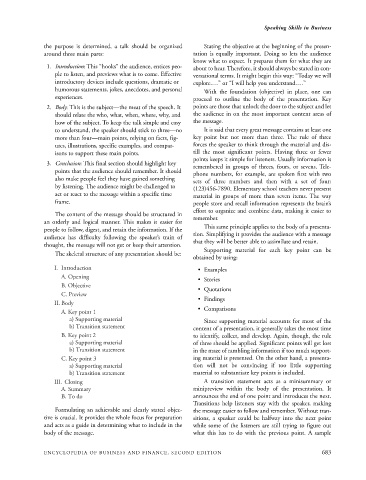Page 706 - Encyclopedia of Business and Finance
P. 706
eobf_S 7/5/06 3:21 PM Page 683
Speaking Skills in Business
the purpose is determined, a talk should be organized Stating the objective at the beginning of the presen-
around three main parts: tation is equally important. Doing so lets the audience
know what to expect. It prepares them for what they are
1. Introduction: This “hooks” the audience, entices peo- about to hear. Therefore, it should always be stated in con-
ple to listen, and previews what is to come. Effective versational terms. It might begin this way: “Today we will
introductory devices include questions, dramatic or explore.…” or “I will help you understand.…”
humorous statements, jokes, anecdotes, and personal With the foundation (objective) in place, one can
experiences. proceed to outline the body of the presentation. Key
2. Body: This is the subject—the meat of the speech. It points are those that unlock the door to the subject and let
should relate the who, what, when, where, why, and the audience in on the most important content areas of
how of the subject. To keep the talk simple and easy the message.
to understand, the speaker should stick to three—no It is said that every great message contains at least one
more than four—main points, relying on facts, fig- key point but not more than three. The rule of three
ures, illustrations, specific examples, and compar- forces the speaker to think through the material and dis-
isons to support these main points. till the most significant points. Having three or fewer
points keeps it simple for listeners. Usually information is
3. Conclusion: This final section should highlight key
remembered in groups of threes, fours, or sevens. Tele-
points that the audience should remember. It should
phone numbers, for example, are spoken first with two
also make people feel they have gained something
sets of three numbers and then with a set of four:
by listening. The audience might be challenged to (123)456-7890. Elementary school teachers never present
act or react to the message within a specific time material in groups of more than seven items. The way
frame. people store and recall information represents the brain’s
effort to organize and combine data, making it easier to
The content of the message should be structured in
remember.
an orderly and logical manner. This makes it easier for
This same principle applies to the body of a presenta-
people to follow, digest, and retain the information. If the
tion. Simplifying it provides the audience with a message
audience has difficulty following the speaker’s train of
thought, the message will not get or keep their attention. that they will be better able to assimilate and retain.
Supporting material for each key point can be
The skeletal structure of any presentation should be:
obtained by using:
I. Introduction • Examples
A. Opening
• Stories
B. Objective
• Quotations
C. Preview
• Findings
II. Body
• Comparisons
A. Key point 1
a) Supporting material Since supporting material accounts for most of the
b) Transition statement content of a presentation, it generally takes the most time
B. Key point 2 to identify, collect, and develop. Again, though, the rule
a) Supporting material of three should be applied. Significant points will get lost
b) Transition statement in the maze of rambling information if too much support-
C. Key point 3 ing material is presented. On the other hand, a presenta-
a) Supporting material tion will not be convincing if too little supporting
b) Transition statement material to substantiate key points is included.
III. Closing A transition statement acts as a minisummary or
A. Summary minipreview within the body of the presentation. It
B. To do announces the end of one point and introduces the next.
Transitions help listeners stay with the speaker, making
Formulating an achievable and clearly stated objec- the message easier to follow and remember. Without tran-
tive is crucial. It provides the whole focus for preparation sitions, a speaker could be halfway into the next point
and acts as a guide in determining what to include in the while some of the listeners are still trying to figure out
body of the message. what this has to do with the previous point. A sample
ENCYCLOPEDIA OF BUSINESS AND FINANCE, SECOND EDITION 683

